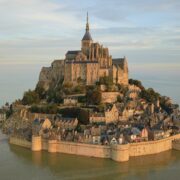Surprising Story: Mont-Saint-Michel and its Bay

A view of Mont-St-Michel, Photo: Johanneke Kroesbergen-Kamps / Unsplash
France has over 49 UNESCO World Historic Sites, five of which are in Paris, but perhaps the most exceptional is the Mont-Saint-Michel. Located on a tidal island off the coast of Normandy, the site has been captivating visitors since its construction in the Middle Ages. I recently participated in a European Federation of Tourist Guide Associations (FEG) webinar to learn about guiding at World Historic Sites. Following this certification, Picturesque Voyages is pleased to announce that we are expanding our excursion offerings to include a day trip to Mont-Saint-Michel. In honor of this, we’re covering the lesser-known aspects of its history and heritage classifications in this latest edition of our Surprising Stories series.
There are various reasons why Mont-Saint-Michel is so unique and inspirational to the millions who visit it every year. The abbey is inseparable from its natural environment. The soaring church, abbey, and fortified town hover above the water, joining the timelessness of the sea to the deeply human desire to reach to the sky. The church and fortified town are also exceptional testimonies of human ingenuity, the spirit that motivated the builders to create these buildings for over three centuries is a testimony to the site’s outstanding human value.
At high tides, we can imagine the church and monastery as they were conceived – a place where monks retreated from civilization. The low tides invite us to consider how the architecture was built, a monumental effort that joined hundreds of workmen over generations. The rising and ebbing tides, which according to tradition arrive at the speed of galloping horses, bring our attention to the harmony between man-made architecture and an extraordinary landscape revealing the authenticity of the place.

Engraving of a map of Mont Saint-Michel from the 18th century / CC
The history of the site dates to the unstable period following the fall of the Roman Empire in Europe around 376 AD when Christianity was arriving in France. At this time, communities of monks lived in present-day Normandy and Brittany amongst the Anglo-Saxon Celtic tribes. According to legend, in 709 AD, the Bishop of Avran had three visions from the Archangel Saint Michel ordering him to build an oratory on what was then called Mont-Tombe. Saint Michel was often depicted as a slayer of dragons, a role that was particularly appreciated on this rocky mount, where the Saint was considered a protector of his faith and of France.
While monks had been praying on the mount for over two hundred years, the first written text about the Abbey dates from the 10th century when the Kings of France gave the island to Benedictine monks, whose order endorsed a communal life isolated from civilization. For this reason, the foundation of the Abbey is dated to 966, when the Benedictine monks built at the very core of the building a church called Notre-Dame-Sous-Terre, (Our Lady Under the Earth). This rather simple barrel-vaulted chapel is now found underneath the nave of the church and preserves some of the oldest vestiges of the site.

Cloister Gardens of the Mont-Saint-Michel Abbey. Photo: Antonin77 / Pixabay
By 1023, the mount became an essential place of pilgrimage in the entire Christian West. The stone masters of the Gothic period, from the 11th to the 16th centuries, built the high walls, the soaring towers, and open platforms that made the Abbey church what we see today. This architectural ensemble is well deserving of its name, “Merville” (Marvel), as it is truly awe-inspiring. The highlight is the cloister garden, its green lawns designed to offer monks a vision of paradise on earth.
During the French Revolution, the State nationalized the site, the monks were expelled from the abbey, and it became a prison until 1862, which is ironically how the building itself was preserved. Today, a monastical presence is ensured by a small community.

Le Mont-Saint-Michel vu du ciel au lever du soleil. Photo: Amaustan / CC
The Medieval Abbey was recognized as a national historic monument in 1862. In 1979 it was inscribed as a World Historic Site, and added to UNESCO’s routes of Saint Jacques de Compostela in France in 1998. The shoreline included in the property is protected by “coastal law” and the bay has been protected since 1994 by the Ramsar Convention It is also recognized as exceptional landscape by ICOMOS in 2014.
Every year over three million tourists visit the church and the surrounding fortified town, which also retains its Medieval architecture. In 2015 a new causeway was constructed to allow a better flow of the tidal basin which consequently restored a key aspect of the monument’s structure and appearance. A footbridge and a shuttle service ensure the transport of visitors from the locality of La Caserne to the foot of the mount. The establishment of this facility has also enabled the regulation of the tourist flow. Moreover, hydraulic construction works, such as the Couesnon Dam where water releases flush the sediments offshore, combat the silting-up of the mount.
If you would like to learn more about Mont-Saint-Michel in person, we can arrange a full-day excursion to the site by chauffeured mini-van. Please contact us here for further details.





Leave a Reply
Want to join the discussion?Feel free to contribute!